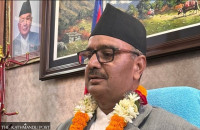National
Regulatory void complicates child adoption process in Nepal
While international adoptions have been banned over child trafficking and abuse concerns, domestic adoptions are also not easy.
Manushree Mahat
Forty-year-old Anistha Shrestha, whose real name has been changed to protect her privacy, had been trying to have a baby for nearly a decade. Following the death of her first newborn in 2011, only 45 days after birth, and another miscarriage some 4 years later, she had all but given up hope. She was suicidal after her losses.
She didn’t care if the child was a newborn, or an adolescent—all she desired was a family.
Shrestha and her husband decided that adoption was the way to go. But things were looking bleak. When they asked for a child through a children’s organisation in Bhaktapur, they were denied. Just when they had begun feeling hopeless again, it was around 2017 that they stumbled upon an abandoned baby boy.
And they began raising him as their own.
At the time when Shrestha was seeking to adopt, there were few legal means to do so. Only in 2017 through the National Civil Code did legal domestic adoption take off.
After years of trying, Shrestha’s encounter with an abandoned baby was a fortunate one for the couple, and the child. It’s been almost a decade now, and the couple couldn’t be happier.
“My son came to me at a time when I had all but given up hope. He means the world to me,” says Shrestha.
After all these years, Nepal’s regulatory mechanisms to effectively pursue adoption are still cumbersome though.
The legal process for child adoption goes like this. Potential parents begin the process of adoption by filing an application at the district court, as well as a deed of adoption, before being considered prospective parents. There are also certain criteria that must be fulfilled in order to qualify for adoption in the country: Couples married up to 10 years, an unmarried man/woman over 45 years of age, widower, divorcee, and judicially separated man/woman, with no son or daughter can be qualified for adoption. While the well-being of children is at heart, the road is still bumpy.
According to Dan Rono, the chief of Child Protection at UNICEF Nepal, children always come first when it comes to any adoption process. Only when no further relations of the children can be found, can they be considered for adoption.
“The law is quite clear here, and we follow the law in order to secure the children’s future. The children are the priority,” he says.
The law clarifies what parents need to do for the children’s best interest. The regulation of the system is another story though.
An official at the National Child Rights Council (NCRC), a government body dedicated to the protection and promotion of child rights, pointed out legal gaps.
Namuna Bhusal, programme manager at the council, said various problems have emerged due to lack of guidelines for adoption. There are no boards, no committees, and no regulations to work in a dedicated way to match children with parents, she said.
“Registration is easier now with the law clarifying the procedures to follow,” she said. “But there are no regulations to guide the adoption process.”
Bhusal said there should be a committee responsible for preparing a list of children eligible for adoption. “The committee needs to know where the children are coming from, whether it is orphanages or hospitals or police stations. Then they’ll look at the parents who’ve been approved for adoption, and facilitate suitable matches,” says the official.
Right now, potential parents themselves find or come across a child they want to adopt and then file for adoption.
As happened with Shrestha a decade ago, that part of the system hasn’t changed. With potential parents themselves having to ‘find’ the children, not only are those who wish to adopt put under strain, the safety of children is also at risk.
There is also a need to hide the origin of the adopted children in Nepali society. To avoid people knowing their child is adopted, potential parents often end up searching for children through illegal means, says Bhusal.
There is also another barrier to adoption. The heteronormativity of the Nepali society, and the law, means that queer communities are unable to adopt and raise their own children.
Pratik Thapa and his partner Renuka Chaudhary have been together for over two years. When their relationship was a year old, they began discussing plans for a child. Then they hit a hurdle. First, their marriage registration process has not been completed, which means they’re not legally recognised as a couple yet. And to make things worse, child adoption requires that a couple be married for 10 years. They also realised that sperm donation was difficult.
“Many in the queer community wish for children, whether it is through sperm donation or adoption, and we want to have children too,” says Thapa.
According to the National Child Rights Council (NCRC), there were tentatively 38 domestic adoptions in the country in the years between 2019 and 2022.
Intercountry adoptions were also popular at one time, much more than domestic ones. Amidst the rise in child trafficking in the name of adoption, inter-country adoption is now out of vogue.
Intercountry adoptions have also been banned in the country since 2019. This has been attributed in part to the lack of a matching committee. With the dissolution of the Inter-Country Adoption Management and Development Committee (ICAB), under the Ministry of Women, Children and Social Welfare, another committee has yet to be assigned to handle inter-country adoptions.
But there’s also more than just the technical aspect that has led to the discontinuation of inter-country adoption. Such adoptions from Nepal have been rife with problems related to trafficking and abuse.
As Rono, Chief of Child Protection at UNICEF, put it, it is of absolute necessity that the child doesn’t have any blood relations left before they can be put up for adoption. But many children who’ve been adopted by couples abroad would have been separated from families, or often have relatives alive.
UNICEF’s 2009 research on inter country adoption also revealed that parents were often unaware of the legal documents relinquishing their parental rights, and some were never even told their children were being put up for adoption.
Child adoption centers have also been embroiled in horrific child sexual abuse scandals. Chief of international adoptions at Bal Mandir, Rabin Shrestha, and Rabin Chalise, who ran a Youth Club centre are currently serving a 17-year jail sentence for sexually exploiting children there.
Bhusal at NCRC says, as is the case with domestic adoptions, negligence in matching children with parents and relatives was the main reason inter-country adoptions were banned.
“Effective regulation is necessary to prevent child abuse and mishandling. Only then will adoptions take off in Nepal,” says Bhusal.




 9.12°C Kathmandu
9.12°C Kathmandu














